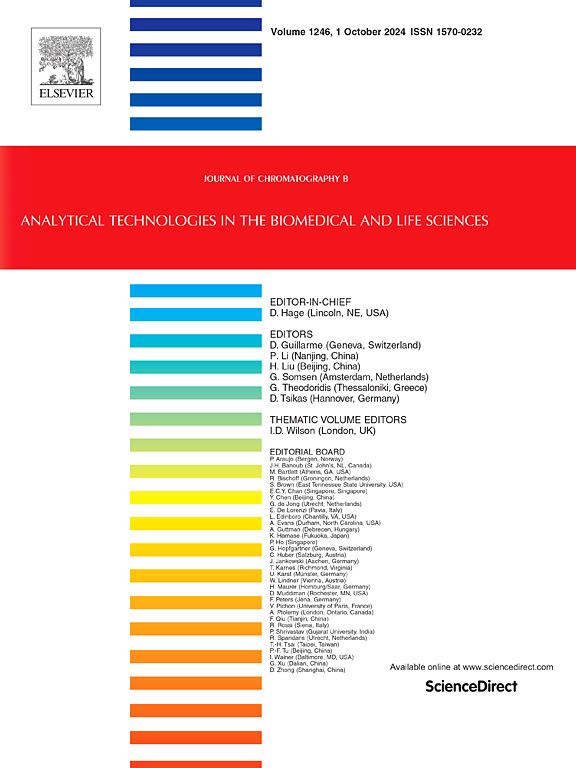利用HILIC-MS/MS对矽肺患者血清中21种氨基酸进行靶向代谢组学分析
IF 2.8
3区 医学
Q2 BIOCHEMICAL RESEARCH METHODS
引用次数: 0
摘要
矽肺病的特点是由于胶原合成改变而形成纤维化病变,其中氨基酸起着至关重要的作用。然而,针对矽肺患者血清氨基酸的代谢组学研究仍然有限。在此,我们开发了一种特异性的血清氨基酸代谢组学方法,用于识别差异氨基酸作为生物标志物,为矽肺的诊断提供敏感可靠的依据。通过优化色谱和制样条件,建立了亲水相互作用液相色谱-串联质谱(HILIC-MS/MS)同时定量血清中21种氨基酸的方法。方法验证结果显示线性良好(r >;0.99),恢复(78.3% - -128.4%)和精度(1.27% - -13.01%)。应用该方法对矽肺患者组(SP;n = 104)和健康对照组(HC;n = 118)。4种氨基酸(谷氨酸、精氨酸、天冬氨酸和鸟氨酸)的浓度在SP和HC之间存在显著差异。单一诊断生物标志物的曲线下面积(AUC)值为0.712 ~ 0.892,谷氨酸-精氨酸联合诊断的AUC值为0.915,灵敏度为86.1%,特异性为90.0%。上述结果表明,筛选了四种用于矽肺诊断的生物标志物,其中谷氨酸成为预测矽肺最准确的单一生物标志物。谷氨酸联合精氨酸进一步提高了诊断效能,提高了敏感性和特异性。本文章由计算机程序翻译,如有差异,请以英文原文为准。
Targeted metabolomics analysis of 21 amino acids in serum of silicosis patients using HILIC-MS/MS
Silicosis is characterized by the formation of fibrotic lesions due to altered collagen synthesis, in which amino acids play a crucial role. However, targeted metabolomics studies of serum amino acids in silicosis patients remain limited. Herein, we developed a specific serum amino acid metabolomics assay for identifying differential amino acids as biomarkers, providing a sensitive and reliable basis for diagnosing silicosis. A hydrophilic interaction liquid chromatography-tandem mass spectrometry (HILIC-MS/MS) method for the simultaneous quantification of 21 amino acids in serum was established by optimizing chromatographic and sample preparation conditions. The method validation results showed good linearity (r > 0.99), recovery (78.3 %–128.4 %) and precision (1.27 %–13.01 %). The developed method was utilized to detect the levels of 21 amino acids in the serum of the silicosis patient group (SP; n = 104) and the healthy control group (HC; n = 118). The concentration of four amino acids (glutamate, arginine, aspartic acid and ornithine) was significantly different between the SP and the HC. Single diagnostic biomarkers exhibited area under the curve (AUC) values ranging from 0.712 to 0.892, while the glutamate-arginine combination achieved superior performance (AUC = 0.915, 86.1 % sensitivity, 90.0 % specificity). The aforementioned results indicate that four biomarkers were screened for the diagnosis of silicosis, with glutamate emerging as the most accurate single biomarker for predicting silicosis. The diagnostic performance was further enhanced by combining glutamate with arginine, which improved both sensitivity and specificity.
求助全文
通过发布文献求助,成功后即可免费获取论文全文。
去求助
来源期刊

Journal of Chromatography B
医学-分析化学
CiteScore
5.60
自引率
3.30%
发文量
306
审稿时长
44 days
期刊介绍:
The Journal of Chromatography B publishes papers on developments in separation science relevant to biology and biomedical research including both fundamental advances and applications. Analytical techniques which may be considered include the various facets of chromatography, electrophoresis and related methods, affinity and immunoaffinity-based methodologies, hyphenated and other multi-dimensional techniques, and microanalytical approaches. The journal also considers articles reporting developments in sample preparation, detection techniques including mass spectrometry, and data handling and analysis.
Developments related to preparative separations for the isolation and purification of components of biological systems may be published, including chromatographic and electrophoretic methods, affinity separations, field flow fractionation and other preparative approaches.
Applications to the analysis of biological systems and samples will be considered when the analytical science contains a significant element of novelty, e.g. a new approach to the separation of a compound, novel combination of analytical techniques, or significantly improved analytical performance.
 求助内容:
求助内容: 应助结果提醒方式:
应助结果提醒方式:


